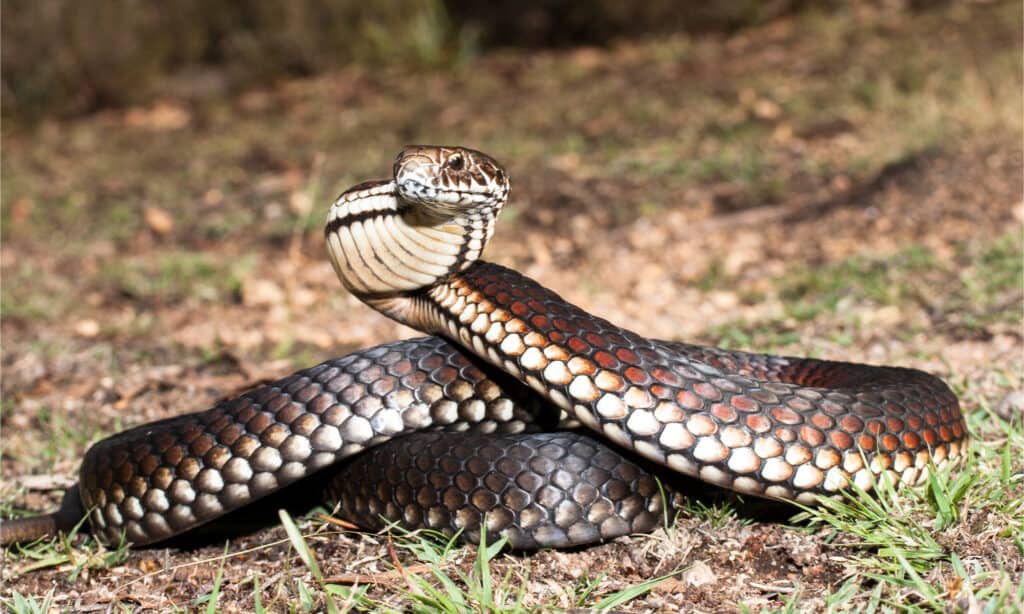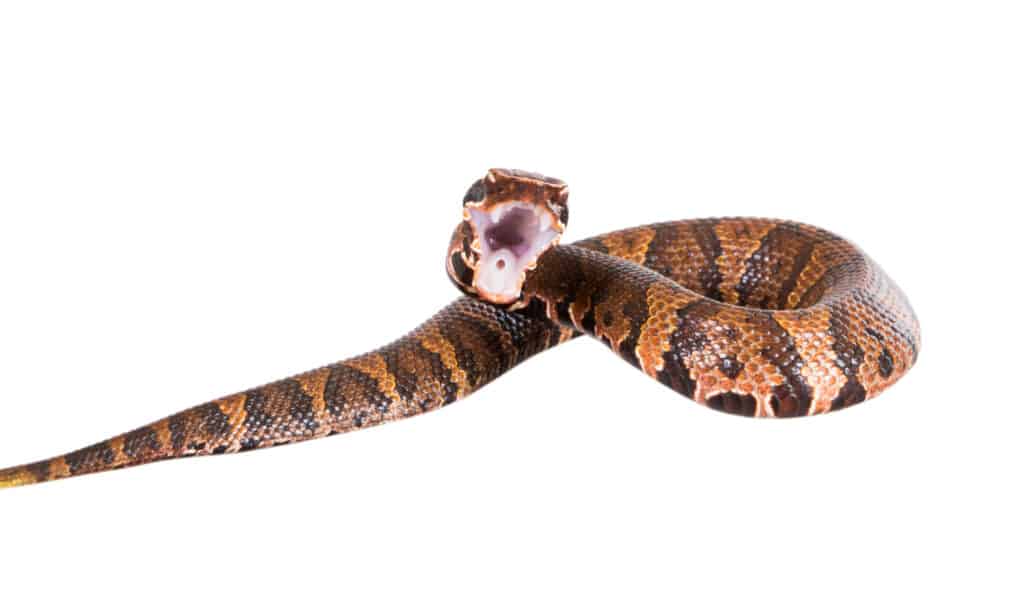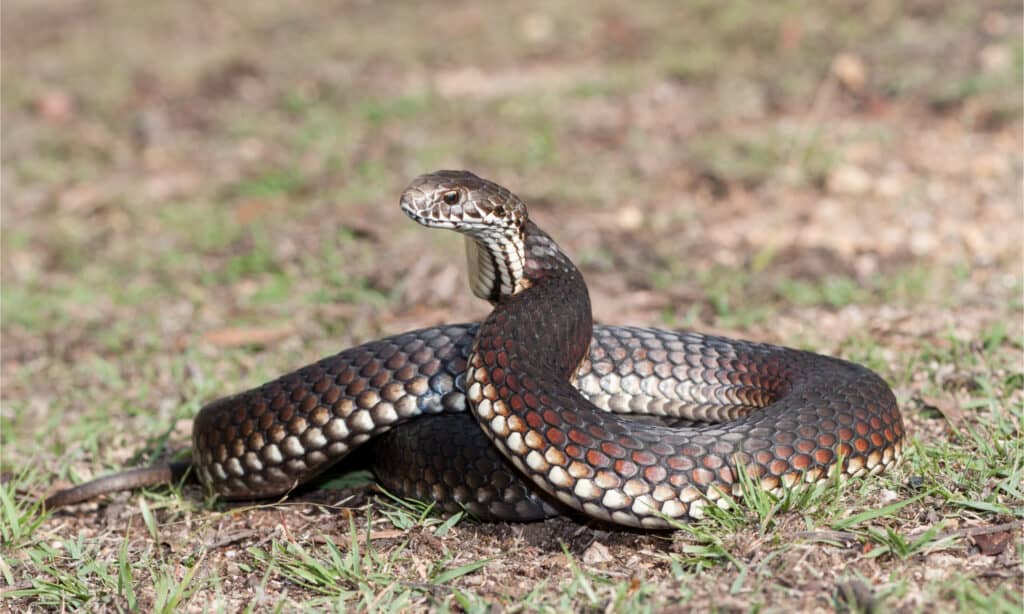Most people assume that Australian copperheads and American copperheads are cousin species. However, these two species aren’t even in the same snake family. Australian copperheads are elapids, while American copperheads are pit vipers.
If you’re wondering what these two species have in common, you’re in luck. This article takes an in-depth look at both species, comparing and contrasting their features.
Discover which is deadlier between Australian copperheads vs American copperheads.
Australian Copperhead vs American Copperhead

| American Copperhead | Australian Copperhead | |
|---|---|---|
| Scientific Name | Agkistrodon, also called eastern copperhead or copperhead | Austrelaps, also called lowland copperheads |
| Snake Family | Pit viper | Elapid |
| Habitat | North America | Southeastern Australia, Tasmania. |
| Subspecies | Previously 5, currently 2 – Eastern copperhead and Broad-banded copperhead | 3 – Pygmy copperhead, Highland copperhead, and Lowland copperhead |
| Size | 0.2 – 0.7 pounds (3.2 – 11.2 ounces) 20-37 in long | 0.25 – 0.75 pounds (4- 12 ounces) 39-59 in long |
| Description | Triangular copper or orange-red heads are always present Dorsal and ventral scales Pale brown to pinkish-brown background skin Hourglass-shaped markings that are colored copper to reddish-brown | Triangular copper or orange-red head may not be present Variable pattern and color (copper, reddish-brown, yellowish or reddish-black |
| Fang Type | Solenoglyphous | Proteroglyphous |
| Hunting style | Heat-sensing pits that help them detect the presence and movement of their prey Stalk and ambush hunters They subdue with venom before swallowing their prey whole Diurnal in the spring and fall, nocturnal during the summer | Stalk and ambush hunters with slender moves They lock their prey in their jaws and quickly inject them with venom before letting them go Diurnal in the spring and fall, nocturnal during the summer |
| Diet | Carnivore Rats, frogs, toads, lizards, small mammals, small snakes, and even other American copperheads | Carnivore Rats, frogs, toads, lizards, small mammals, small snakes, and even other lowland copperheads |
| Bite | Common symptoms: extreme pain, swelling, throbbing, tingling, severe nausea Bites are fairly common as people unknowingly step on/near them a lot | Common symptoms: extreme pain, inability to breathe or move body parts, dizziness, severe nausea Bites are extremely rare |
| Venom | Hemotoxic venom Hemotoxins damage tissue where they are injected | Neurotoxic venom Neurotoxins cause paralysis and can lead to death |
| Defense Mechanisms | Venom Musk | Venom |
| Temperament | They freeze when humans come near. This causes people to unknowingly step on/near them a lot and get bitten | Docile and shy They retreat when humans are near |
Key Differences Between the Australian Copperhead and the American Copperhead
The key differences between the Australian copperhead and the American copperhead lie in their size, habitat, fang type, and family. Let’s look at these in detail alongside other differences.
Australian Copperhead vs American Copperhead: Scientific Name

American copperheads are pit vipers, while Australian copperheads are elapids.
©Creeping Things/Shutterstock.com
Australian copperheads (Austrelaps) are elapid snakes native to Australia. They are venomous and are known to have 3 subspecies: pygmy, highland, and lowland copperheads.
American copperheads (Agkistrodon contortrix) are pit vipers native to Northern America. Previously they were classified into 5 subspecies:
- Southern copperhead (Agkistrodon contortrix contortrix)
- Broad-banded copperhead (Agkistrodon contortrix laticinctus)
- Northern copperhead (Agkistrodon contortrix mokasen)
- Osage copperhead (Agkistrodon contortrix phaeogaster)
- Trans-Pecos copperhead (Agkistrodon contortrix pictigaster)
However, now there are only 2 recognized American copperhead subspecies: eastern copperhead (Agkistrodon contortrix)and broad-banded copperhead (Agkistrodon laticinctus).
Australian Copperhead vs American Copperhead: Size

On average, Australian copperheads weigh 3.2 – 11.2 ounces while American copperheads weigh 4- 12 ounces.
©Ken Griffiths/Shutterstock.com
Australian copperheads are heavier than American copperheads. On average, Australian copperheads weigh 0.2 – 0.7 pounds (3.2 – 11.2 ounces), while American copperheads weigh 0.25 – 0.75 pounds (4- 12 ounces)
Australian copperheads are considerably longer than American copperheads. They measure from 39-59 inches in length, while American copperheads measure 20-37 inches.
While American copperheads all have triangular copper or orange-red heads, not all Australian copperheads do. Australian copperheads have more variability in color and pattern compared to American copperheads that are easy to identify via color and pattern.
Australian Copperhead vs American Copperhead: Fang Type

American copperheads have solenoglyphous fangs, while Australian copperheads have proteroglyphous fangs.
©IrinaK/Shutterstock.com
American copperheads, like all vipers, have solenoglyphous fangs. They are hollow, foldable, and designed to inject their venom as deeply as possible. Australian copperheads have proteroglyphous fangs which all elapids have.
They are fixed but inject venom with remarkable speed. Neither fang is more dangerous than the other. What matters more regarding potency is how toxic or strong the snake’s venom is as well as its venom yield and lethal dose.
Australian Copperhead vs American Copperhead: Hunting style
All copperheads are diurnal in the spring and fall but nocturnal during the summer due to the temperature change. Copperheads also swallow their prey whole. Australian copperheads lie in wait for their prey. They lock their prey in their jaws and quickly inject them with venom before letting them go.
American copperheads attack and kill in various ways depending on the size of their prey. If it is a small prey, after injecting it with venom, they hold it between their jaws and wait for it to give in to the venom.
However, with larger prey, they simply hold them long enough to inject them with venom and then let them go. When they surrender to the venom, American copperheads claim their prize.
Australian Copperhead vs American Copperhead: Bite
Statistics shows that American copperheads bite more people in the USA than any other snake (2,920). This isn’t the same for Australian copperheads. Australian copperheads must be substantially provoked for them to bite.
When Australian copperheads spot humans, they slither away. American copperheads freeze in hopes of camouflaging. This is why Americans accidentally step on them more than other snakes.
Only one death from copperhead bites has been recorded in Australia. The case fatalities for American copperhead bites is 0.01%.
Australian Copperhead vs American Copperhead: Venom
American copperheads have hemotoxic venom with rectifiable effects. Hemotoxins damage bone and muscle tissue where they touch. However, if treated, the damage is rectifiable. Their bites are hardly ever fatal to humans.
Eastern copperheads, for example, have an estimated lethal dose of around 85- 100 mg but yield 26 mg of venom on average- with a maximum of 85 mg. Most of their bites are dry warning bites that contain no venom.
Australian copperheads have neurotoxic venom. Neurotoxic venom is one of the fastest venom to act. It works by attacking the nervous system and stopping the transmission of signals from the nerves to the muscles. In simple terms, this leads to paralysis of the nervous and respiratory systems.
Neurotoxins can lead to death if not treated in time.
Australian Copperhead vs American Copperhead: Which is Deadlier?

Australian copperheads are deadlier than American copperheads.
©Ken Griffiths/Shutterstock.com
Australian copperheads inject neurotoxic venom in sizeable quantities, while American copperheads are known for dry bites. Considering their venom composition and yield, Australian copperheads are deadlier than American copperheads.
Next Up…
The photo featured at the top of this post is © Joe McDonald/Shutterstock.com
Discover the "Monster" Snake 5X Bigger than an Anaconda
Every day A-Z Animals sends out some of the most incredible facts in the world from our free newsletter. Want to discover the 10 most beautiful snakes in the world, a "snake island" where you're never more than 3 feet from danger, or a "monster" snake 5X larger than an anaconda? Then sign up right now and you'll start receiving our daily newsletter absolutely free.
Thank you for reading! Have some feedback for us? Contact the AZ Animals editorial team.






